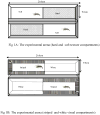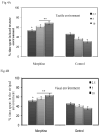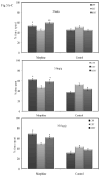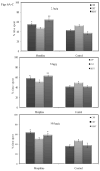Drug-seeking behavior in an invertebrate system: evidence of morphine-induced reward, extinction and reinstatement in crayfish
- PMID: 18822319
- PMCID: PMC2669653
- DOI: 10.1016/j.bbr.2008.08.043
Drug-seeking behavior in an invertebrate system: evidence of morphine-induced reward, extinction and reinstatement in crayfish
Abstract
Several lines of evidence suggest that exploring the neurochemical basis of reward in invertebrate species may provide clues for the fundamental behavioral and neurobiology underpinnings of drug addiction. How the presence of drug-sensitive reward relates to a decrease in drug-seeking behavior and reinstatement of drug-seeking behavior in invertebrate systems is not known. The present study of a conditioned place preference (CPP) paradigm in crayfish (Orconectes rusticus) explores morphine-induced reward, extinction and reinstatement. Repeated intra-circulatory infusions of 2.5 microg/g, 5.0 microg/g and 10.0 microg/g doses of morphine over 5 days serve as a reward when paired with a distinct visual or tactile environment. Morphine-induced CPP was extinguished after repeated saline injections for 5 days in the previously morphine-paired compartment. After the previously established CPP had been eliminated during the extinction phase, morphine-experienced crayfish were challenged with 2.5 microg/g, 5.0 microg/g and 10.0 microg/g, respectively. The priming injections of morphine reinstated CPP in all training doses, suggesting that morphine-induced CPP is unrelenting, and that with time, it can be reinstated by morphine following extinction in an invertebrate model just like in mammals. Together with other recent studies, this work demonstrates the advantage of using crayfish as an invertebrate animal model to investigate the basic biological processes that underline exposure to mammalian drugs of abuse.
Figures







Similar articles
-
Drug-sensitive reward in crayfish: an invertebrate model system for the study of SEEKING, reward, addiction, and withdrawal.Neurosci Biobehav Rev. 2011 Oct;35(9):1847-53. doi: 10.1016/j.neubiorev.2010.12.008. Epub 2010 Dec 21. Neurosci Biobehav Rev. 2011. PMID: 21182861 Free PMC article. Review.
-
Reinstatement of morphine-induced conditioned place preference in mice by priming injections.Neural Plast. 2003;10(4):279-90. doi: 10.1155/NP.2003.279. Neural Plast. 2003. PMID: 15152982 Free PMC article.
-
Effects of a single and repeated morphine treatment on conditioned and unconditioned behavioral sensitization in Crayfish.Behav Brain Res. 2010 Mar 5;207(2):310-20. doi: 10.1016/j.bbr.2009.10.010. Epub 2009 Oct 29. Behav Brain Res. 2010. PMID: 19836421
-
Forced swim stress but not exogenous corticosterone could induce the reinstatement of extinguished morphine conditioned place preference in rats: involvement of glucocorticoid receptors in the basolateral amygdala.Behav Brain Res. 2014 May 1;264:43-50. doi: 10.1016/j.bbr.2014.01.045. Epub 2014 Feb 5. Behav Brain Res. 2014. PMID: 24508237
-
Effects of a Rhodiola rosea L. extract on the acquisition, expression, extinction, and reinstatement of morphine-induced conditioned place preference in mice.Psychopharmacology (Berl). 2012 May;221(2):183-93. doi: 10.1007/s00213-012-2686-0. Epub 2012 Mar 16. Psychopharmacology (Berl). 2012. PMID: 22421739
Cited by
-
Crayfish Learning: Addiction and the Ganglionic Brain.Perspect Behav Sci. 2018 Nov 7;41(2):417-429. doi: 10.1007/s40614-018-00181-z. eCollection 2018 Nov. Perspect Behav Sci. 2018. PMID: 31976403 Free PMC article.
-
Simple Aesthetic Sense and Addiction Emerge in Neural Relations of Cost-Benefit Decision in Foraging.Sci Rep. 2020 Jun 15;10(1):9627. doi: 10.1038/s41598-020-66465-0. Sci Rep. 2020. PMID: 32541824 Free PMC article.
-
Recovery-from-extinction effects in an anuran amphibian: renewal effect, but no reinstatement.Anim Cogn. 2022 Apr;25(2):359-368. doi: 10.1007/s10071-021-01558-5. Epub 2021 Sep 1. Anim Cogn. 2022. PMID: 34468877
-
The Sensitivity of the Crayfish Reward System to Mammalian Drugs of Abuse.Front Physiol. 2017 Dec 6;8:1007. doi: 10.3389/fphys.2017.01007. eCollection 2017. Front Physiol. 2017. PMID: 29270131 Free PMC article. Review.
-
d-Amphetamine stimulates unconditioned exploration/approach behaviors in crayfish: towards a conserved evolutionary function of ancestral drug reward.Pharmacol Biochem Behav. 2011 Jul;99(1):75-80. doi: 10.1016/j.pbb.2011.04.004. Epub 2011 Apr 12. Pharmacol Biochem Behav. 2011. PMID: 21504757 Free PMC article.
References
-
- Davis W, Smith SG. Role of conditioned reinforcers in the initiation, maintenance and extinction of drug-seeking behavior. Pavlov J Biol Sci. 1976;11(4):222–36. - PubMed
-
- Burbassi S, Cervo L. Stimulation of serotonin(2C) receptors influences cocaine-seeking behavior in response to drug-associated stimuli in rats. Psychopharmacology (Berl) 2008;(1):15–27. - PubMed
-
- Cervo L, Carnovali F, Stark JA, Mennini T. Cocaine-seeking behavior in response to drug associated stimuli in rats: involvement of D3 and D2 dopamine receptors. Neuropsychopharmacology. 2003;28(6):1150–9. - PubMed
-
- Lu L, Grimm J, Hope B, Shaham Y. Incubation of cocaine craving after withdrawal: a review of preclinical data. Neuropharmacology. 2004;47 1:214–26. - PubMed
-
- O'Brien C, Childress AR, McLellan AT. Classical conditioning in drug dependent humans. Ann N Y Acad Sci. 1992;654:400–15. - PubMed
Publication types
MeSH terms
Substances
Grants and funding
LinkOut - more resources
Full Text Sources

